| Columns Retired Columns & Blogs |
Great report.
The next record I played, Black Uhuru's Sly & Robbie– produced 1981 album, Red (LP, Mango ZCM 9625), demonstrated that, with the right phono stage and record player, a modest cartridge like the AT-VM95SH is able to play some recordings more effectively than middle- or top-shelf cartridges. In this case, I thought the Audio-Technica's distribution of force, bass weight, transient slam, and unbelievable pace, rhythm, and timing made "Sponji Reggae" and the whole Red album more enjoyable than with any of my fancy-pants cartridges. I played "Sponji Reggae" once more, this time with the $49 (!) Audio-Technica AT-VM95E, the elliptical-stylus version of the VM95. Now the sound had even more pulse and reggae energy. The music was more powerfully there (in my room) than it had been with the Shibata-tipped version.
The Marantz phono input played moving-magnet cartridges in a manner that would satisfy all but the most affluent and persnickety audiophiles.
But what about moving coils?
Unlike the Yamaha A-S3200 integrated, which provided a fixed 50 ohm load for moving coils, the Model 30 gives the user three loading choices: 33 ohms, 100 ohms, and 390 ohms. This made me curious how the popular and overtly musical Zu Audio–modified Denon DL-103 (from $499) (Zu/DL-103 Mk.II, Rev-B) moving coil might fare with the Marantz.
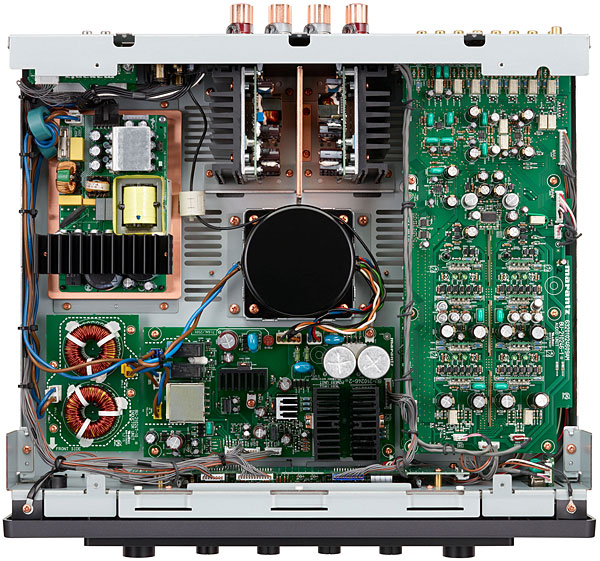
The Zu Audio spec sheet recommends a 200–300 ohm load, so I started with the Marantz's 100 ohm setting. "Sponji Reggae" sounded a little lumpy-gravy and rolled off. Switching to the 390 ohm load perked the sound up nicely. The Black Uhuru album came across forceful, detailed, and infinitely layered. The Marantz with the Zu Denon recovered a sense of the album's mix; it was fun to notice how each track displayed its own separate reverb and fabric of detail. Impressive for a built-in phono preamp.
Driving Maggies
I'd been enjoying the Marantz Model 30 with every speaker I tried, including the 15 ohm Falcons, but with the $1400/pair Magnepan .7 quasi-ribbon panel speakers, my heart started pounding in my chest and heart emojis spewed forth into the room. The Model 30's Hypex-based amplifier seemed to come alive with the 4 ohm Magnepan load. Stravinsky Conducts Histoire Du Soldat Suite (LP, Columbia MS 7093), traced by the humble Zu Denon moving coil, had me laughing, muttering "oh my God," shaking my head, thinking, if this is how an approximately $6k hi-fi sounds, who needs more?
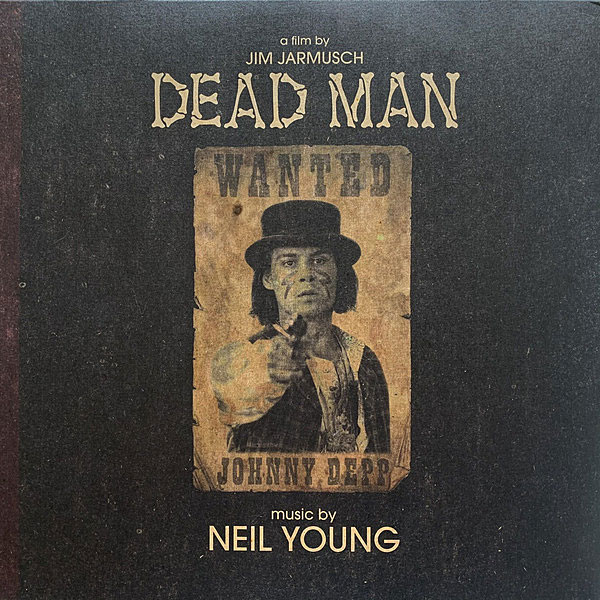
The Maggie-Marantz combo made sound images that were tall and precisely mapped. It was pure stay-up-late pleasure to gaze into their holographic enticements. Listening to Neil Young's soundtrack to Jim Jarmusch's film Dead Man (16/44.1 FLAC, Vapor Records/Qobuz), the Marantz Model 30 powering the .7 Magnepan panels took me further and more clearly into the dark campfire conversations of William Blake (Johnny Depp) and Nobody (Gary Farmer) than I had ever been before. The Marantz and Maggie .7 combo pulled out shovelsful of previously hidden subtleties.
I believe you'd have to spend at least $10k more to beat the LSD detail, CinemaScope soundstage, Technicolor tone, and nuanced dynamics of the Marantz integrated driving the .7 Magnepans.
The Marantz Model 30 is clearly a speaker-friendly amplifier.
Marantz vs Yamaha
The $7499.95 Yamaha A-S3200 integrated costs three times as much as the $2499 Marantz Model 30. The Yamaha specifies 100Wpc into 8 ohms and 150Wpc into 4 ohms (class-AB). The Marantz claims 100Wpc into 8 ohms and 200Wpc into 4 ohms (class-D). My first Yamaha-Marantz comparison involved playing Miles Davis's Jack Johnson to see which amp put Miles's soundtrack in the room with more force.
With the Yamaha driving the GoldenEar BRXes, Miles's Jack Johnson sounded powerful and clean with full-tilt pace, rhythm, and engagement. It packed a quick, strong punch.
The Marantz counter-punched by delivering a quieter, more introspective interpretation. With the Marantz, the ether depths of the soundstage were a grainless, ivory black; with the Yamaha, they were a slightly grainy, overcast gray.
My next Yamaha-Marantz comparison continued my explorations into the vaguely art-rocky but uncategorizable compositions of a French musician named Pascal Comelade.
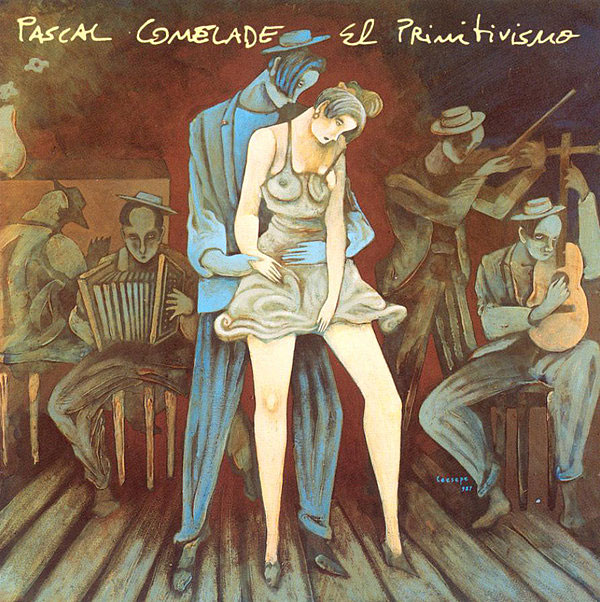
Every song on his 2015 album El Primitivismo (16/44.1 FLAC DiscMedi Blau/Tidal) is filled with plastic-guitar and toy-piano fun. Just four or five plastic-guitar notes into the first track, "Valse de la Demoiselle aux Yeux Verts," I was sold on the album.
With the Yamaha, the calliope melodies on "Les Filles du Calvaire" stuck in my head for days after hearing them. The mad rock-guitar mashup on "Rock del Veneno" made perfect use of the A-S3200's best traits: slam, clarity, and full-force boogie factor. With this song playing through the Harbeth P3ESRs, I thought the Yamaha sounded like a spiffier, more transparent, more refined-and-detailed Schiit Ragnarok. It had the Raggy's lower-midrange punch but with a lot more fresh air at the top.
As I listened with the Yamaha, I tried to imagine what the less expensive Marantz Model 30 might do with calliopes and toy pianos. When I swapped the Marantz in, I realized I was comparing two radically different sonic signatures: the Yamaha representing bright-n-ready, old-school, class-AB vivo, while the Marantz sounded darker, less extraverted, with more silence in the silences and more space in the soundspaces.
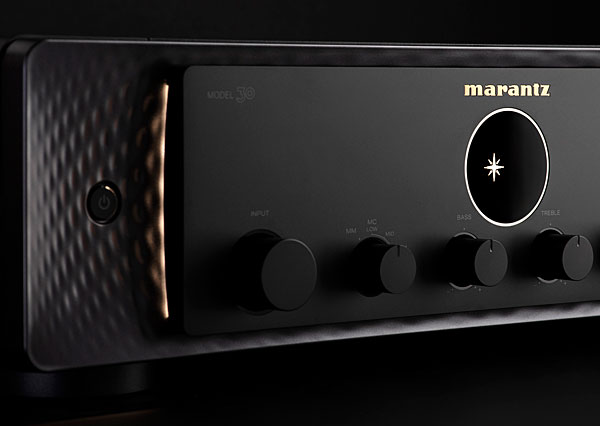
What the Marantz lacked was the grit and growl the Yamaha had given the electric guitars on Comelade's "Rock del Veneno." The Yamaha's muscular fierceness made the Marantz seem withdrawn. Throughout El Primitivismo, the Marantz put a greater, atmospheric distance between me and the various instruments. Performers seemed less there. On the positive side, the Marantz put its deeper silence and vaster space to good use by filling it with webs of layered detail that had been obscured with the Yamaha.
Surprisingly, with the Marantz I found myself reveling more in the top five octaves, not the bottom five, as I usually do with class-D amplifiers.
Compared to Rogue Audio Sphinx V3
When I switched from the $2500 Marantz Model 30 to the $1595 Rogue Audio Sphinx V3, with the GoldenEar BRX speakers, the first difference I noticed was how much more solid, textural, and tone-correct the Rogue seemed. Driven by the HoloAudio May DAC, the Sphinx V3 played darker and a little grainier than the Model 30. But the woody naturalness of the V3's tone forced me to forget about critical listening.
At one point in my Rogue–Marantz comparisons, I was playing my promo copy of Lead Belly's life-affirming June 1949 performance at the University of Texas, Austin (LP, Playboy Records PB-119). I was using the Audio-Technica VM95ML moving magnet cartridge through the Marantz Model 30's phono input. The sound was more distant than I remembered it. As soon as side 2 finished, I substituted the Sphinx V3 (and its phono stage) and played it again. The opening applause and Huddie's voice were clearer and more present. The side 2 track 8 "Goodnight Irene" sing-along was crisp and "you are there" in feel.
Overall, the Rogue amp's class-D clarity emphasized music's bottom five octaves, especially the lower midrange, while the Marantz version of class-D clarity brought greater transparency to the upper five octaves, in a way I have not previously experienced with any class-D module.
Headphone amplifier
When I plug headphones into the 3.5mm headphone jack of an integrated amplifier under review, I expect the sound to be less distorted, more dynamic, more sharply focused, and overall more intelligible than what I've been getting from the floor speakers. I am almost always disappointed. With the Model 30's headphone output, I was impressed.
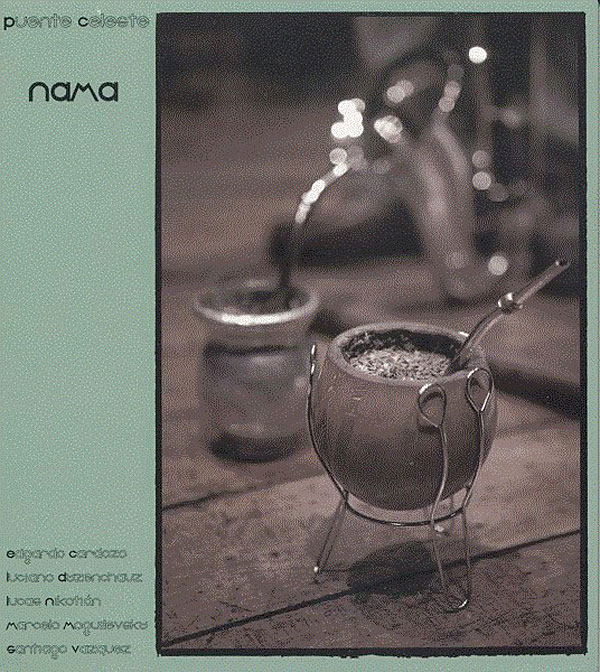
I started with the sensitive (104dB/mW), easy-to-drive (55 ohm) Focal Clear headphones and smiled immediately. The sound, from an M•A Recordings CD, Nama by Puente Celeste (M•A MO84a), was similar to but more openly and precisely rendered than the sound from the Model 30 driving the Magnepan .7 quasi-ribbon panels.
I was using the Marantz SACD 30n player (see sidebar), so what I was experiencing was the full Marantz CD-player/DAC/amp sound. Besides the CD, I have this recording in a 24/176 file and a pure native DSD file. I've heard it a million times, and I know it well; this Marantz-Focal partnering was doing an extraordinary job of separating all the players and instruments, evidencing no conspicuous cross-feeding. Best of all, the tone and texture was alluring.
Next, I tried playing Horowitz in Moscow (16/44.1 FLAC Deutche Grammophon/Qobuz) through the expensive ($6000) and much less sensitive (83dB/mW) 60 ohm HiFiMan Susvara. What I experienced was totally unexpected. Before the end of Domenico Scarlatti's Sonata in E Major (K.380), I was laughing and applauding! Headphone stages in moderately priced integrated amps are not supposed to have the gain or power to drive the Susvara. With the Model 30, the Susvara played the aforementioned Horowitz, Lead Belly, and Miles Davis albums with astounding clarity and drive. I played Son of Dave's sensational version of Lead Belly's "Black Betty" from Explosive Hits, and it brought me to tears and smirking! (24/88.2 FLAC Goddamn Records/Qobuz).
The Model 30's headphone amp did fall short—power, gain, and distortion-wise—when I challenged it with deep, complex bass on "Nobody" and "We Shall Be Happy" off Ry Cooder's Jazz album (16/44.1 FLAC Rhino Atlantic/Qobuz). Nevertheless, any headphone sporting a sensitivity of 88dB/mW or better should partner nicely with the Model 30's headphone output.
I now believe
I "get" this amp. The Marantz Model 30 integrated suits my taste for simple sophistication. Its phono stage is so versatile and musically effective that I see this moderately priced integrated as being an especially good choice for young people getting into LP collecting for the first time or older audiophiles who want to start over with analog after having sold their LPs in the '90s.
Best of all, this stylish new Marantz is a well-tuned, supertransparent, superdetailed class-D amplifier that powered diverse loudspeakers with a captivating élan worthy of its "Model 30" heritage.


I don't understand why this Model 30 amp and the accompanying SACD player don't have balanced XLR between them? It's a shame that Marantz seems to be saving that feature for their top-of-the-line Reference series.

I don't like the look of those tone control curves. They have pushed the inflection points up so high and down so low that, in my experience, all you end up getting is just a little extra dull thudding way down low and some extra hiss way up top -- but not any real change in the bass-treble balance. I know they do this thinking they want to "keep the tone controls out of the all-important midrange," but I wish Marantz and other brands would learn not to do this. The kind of implementation you see on the old NAD M3, for example, is much better. If it wasn't for this slip-up, I'd be really interested in this.

...entry level audiophile with Powah.
Where is the "I Believe"?
I like the "captivating elan" which suggests an attractive/eager performer capable of holding a listener's attention.
I'd wager that this do-it-all device is 5 times better than what the vast citizen majority will ever own. ( and probably 5 times the price )
Based on your review, I'd buy it to gift to my Grandchildren.
Tony in Venice

It was a wonderfully open and incredibly free album... and THE first recording I could remember from my childhood.
My favorite 1st grade teacher played this for us in class and Rosy Grier's song 'It's Allright to Cry" and let us know that no matter how tough and 'manly' one thinks they are... it takes strength shows show vulnerability and sadness.
So cool this and you are!

Why do you do a 50 Hz test? Is this to try to assess the performance of the PSU?
I understand£ why you’re do one at 1 kHz or 19+20 kHz CCIF but not the 50 Hz test.
Thank you

Why do you do a 50 Hz test? Is this to try to assess the performance of the PSU?
I started doing this test at the end of the 1980s, following a precedent set by the UK's Martin Colloms: the signal is 10Hz away from the AC power-line frequency, so will reveal supply stress.
John Atkinson
Technical Editor, Stereophile

Herb, I love your writing style. I think you could compose a piece about the dirt in your garden and I might find it compelling. That you choose to write about glamorous and/or interesting audio gear is just a bonus for this reader.
Much obliged-
David Hicks
Ashland, OR

Ironically - after reading the actual magazine - this is the first clear picture I have seen of the amp - why do all the pics in the magazine so tangentially represent what the actual equipment looks like?

Hi Herb:
I assume you were attending NIU. I graduated from NIU in '71. Did you ever purchase any equipment Apple Tree? Mike let me order LPs wholesale through his store. I had a side-hustle selling LPs in Stevenson S. Also got my own LPs pretty cheap.

I was in the art department at NIU. I graduated in 1973.
My painting studio was in the Wurlitzer Factory by the river.
I wish I had one of those DeKalb Corn hats now.
lol
hr

Looks like Model 30 and SACD30n are meant to be paired together..... Any chance for a more thorough review of the SACD30n ?

From the comparison with the Rogue Sphinx, I come away feeling like you prefer that amp. I realize they are different sounding integrateds, but when one sounds "much more solid, textural and tone-correct," I would gravitate to that amp.

Hmmm....so I bought a Model 30 to replace a Sunfire Signature Series 2. The Sunfire was a beast 600W+ per channel. I used to have Maggie 3.7s and needed power to drive them. Then I moved to the Triton One.Rs which have powered woofers so thought I no longer needed that power and decided to move to an integrated from separates. My impressions so far 1) Marantz has goosed bass and midrange with this amp. The midrange/upper bass has been tweaked so much that some things - vocals on Joni Mitchell's Blue, and Neil Young on Harvest sound strained to me. The Tritons don't need the help there. I keep thinking that if I still had the Maggies, this thing would sound amazing with those. IMO they need the bass and midrange to be pumped up. 2) My second realization - even though the tritons have powered woofers, they still like power. The Sunfire never even breathed hard - when I turn up the Marantz I again feel like there's a bit of a strain....